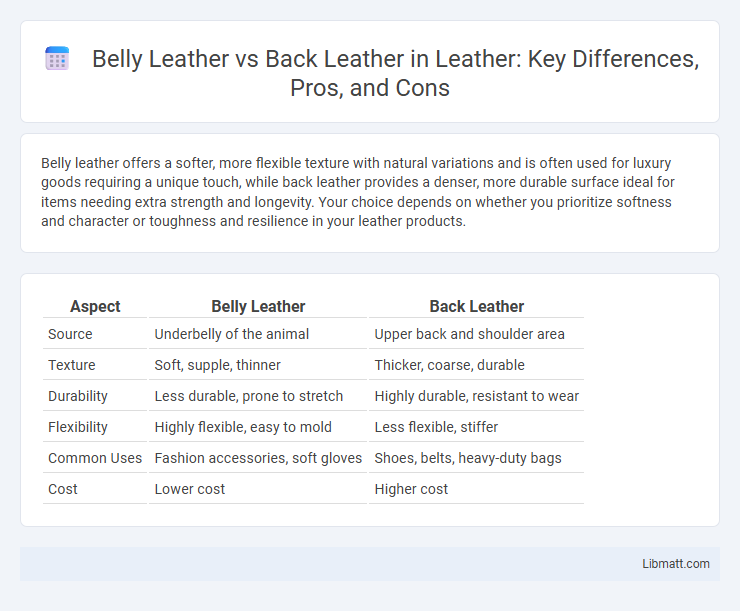Belly leather offers a softer, more flexible texture with natural variations and is often used for luxury goods requiring a unique touch, while back leather provides a denser, more durable surface ideal for items needing extra strength and longevity. Your choice depends on whether you prioritize softness and character or toughness and resilience in your leather products.
Table of Comparison
| Aspect | Belly Leather | Back Leather |
|---|---|---|
| Source | Underbelly of the animal | Upper back and shoulder area |
| Texture | Soft, supple, thinner | Thicker, coarse, durable |
| Durability | Less durable, prone to stretch | Highly durable, resistant to wear |
| Flexibility | Highly flexible, easy to mold | Less flexible, stiffer |
| Common Uses | Fashion accessories, soft gloves | Shoes, belts, heavy-duty bags |
| Cost | Lower cost | Higher cost |
Introduction to Belly Leather and Back Leather
Belly leather, sourced from the softer, more flexible underside of an animal, exhibits a unique grain pattern and offers enhanced pliability, making it ideal for detailed leather goods and garments that require comfort. Back leather, taken from the tougher, more durable upper side, provides greater strength and structure, commonly used in high-stress applications like footwear and saddlery. Understanding the differences between belly leather and back leather helps you choose the right material based on durability needs and aesthetic preferences.
Defining Belly Leather: Characteristics and Qualities
Belly leather is characterized by its soft, supple texture and natural stretch, making it highly prized for products requiring flexibility and comfort. This section of the animal's hide features fine grain patterns with visible pores, allowing for excellent dye absorption and a distinctive aesthetic appeal. Your choice of belly leather ensures durability combined with a luxurious feel, ideal for high-quality leather goods.
Understanding Back Leather: Features and Traits
Back leather is known for its durability and uniform grain, making it ideal for furniture and heavy-use items. It typically has a smoother texture compared to belly leather, which often features more natural markings and stretch. Understanding these traits helps you select leather suited to your project's longevity and aesthetic needs.
Key Differences Between Belly and Back Leather
Belly leather features a looser grain with more stretch and natural markings, making it less uniform but highly flexible, while back leather is tighter, denser, and more consistent in texture, providing increased durability and strength. The belly section often includes more scars and wrinkles due to the animal's natural movement, whereas back leather is smoother and more resistant to wear. Your choice depends on whether you prioritize softness and flexibility or toughness and a refined appearance.
Durability Comparison: Belly vs. Back Leather
Back leather exhibits superior durability due to its tighter grain structure and thicker fiber composition, making it more resistant to wear and tear compared to belly leather. Belly leather, characterized by its softer and more flexible texture, tends to be less durable and more prone to stretching and scuffing over time. For applications demanding long-lasting performance, back leather is the preferred choice owing to its enhanced strength and abrasion resistance.
Visual Appeal and Grain Texture
Belly leather features a more pronounced grain texture with natural scars and stretch marks, offering a unique and rustic visual appeal prized in artisanal leather goods. Back leather exhibits a tighter, smoother grain that provides a uniform and polished look favored in luxury leather products where consistency is key. The choice between belly and back leather depends on desired aesthetics: belly leather for character-rich, textured finishes and back leather for sleek, refined appearances.
Typical Uses in Leathercraft and Industry
Belly leather, known for its flexibility and softness, is ideal for crafting gloves, wallets, and detailed leather accessories requiring intricate work. Back leather, characterized by its toughness and durability, is commonly used in making belts, saddles, and heavy-duty footwear where strength is essential. Both types serve distinct purposes in leathercraft and industry based on their structural properties and intended functional demands.
Cost and Value Analysis
Belly leather is typically more affordable due to its thinner, less durable nature compared to back leather, which commands higher prices for its robustness and longevity. The value of back leather lies in its tight grain and strength, making it ideal for premium products that require durability and a refined appearance. Consumers seeking cost-effective options may prefer belly leather, but investing in back leather offers superior long-term performance and aesthetic appeal.
Choosing the Right Leather for Your Project
Belly leather offers a softer, more flexible texture ideal for projects requiring pliability, while back leather provides a firmer, more durable option suited for structured items like belts or wallets. Understanding your project's needs for flexibility versus durability helps you select the appropriate leather type. Consider the intended use and desired finish to ensure your leather choice enhances the final product's quality and longevity.
Conclusion: Which Leather Type Should You Choose?
Belly leather offers a softer texture and more flexibility, making it ideal for lightweight accessories and fashion items, while back leather provides greater durability and a firmer structure suited for heavy-duty goods like belts and boots. Your choice depends on whether you prioritize comfort and pliability or long-lasting strength and support. Selecting the right leather type tailored to your project's needs ensures optimal performance and aesthetic appeal.
Belly leather vs back leather Infographic

 libmatt.com
libmatt.com